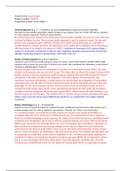Student name: Joyce Burger
Student number: 2635273
Assignment number (in the table): 3
General approach (e.g. 2 – 5 sentences, of course depending on what you need to describe)
Starting from your problem description, explain the goal of your project in your own words. Will opt for a forward
or reverse genetics approach? Provide an argumentation.
By making a knock-out model for the human gene named nephrin (NPHS1), the goal is to see if this gene
is related to kidney function. The reversed genetic approach is used to make this model. Via reversed
genetics, the endogenous gene, (NPHS1), present in the model will be eliminated, so a null allele is
created. Based on previous literature, the phenotype of the model will be studied to see if the kidney is
still functioning in the model in the absence of NPHS1. (Kaukinen A, Kuusniemi A-M, Lautenschlager I,
Jalanko H. Glomerular endothelium in kidneys with congenital nephrotic syndrome of the Finnish type
(NPHS1). Nephrology Dialysis Transplantation. 2007;23(4):1224-32.)
Choice of model organism (e.g. 8-12 sentences)
Indicate for each of the four model organisms (mouse, fly, worm, yeast) if they would be suitable. Which model
organism will you choose for your project? Motivate your choice, also considering the evolutionary conservation if
you have a predefined gene of interest.
Because the goal of the study is to investigate the function of a human gene named NPHS1, the most
suitable model organism we can use is the mouse. The reason why we choose the mouse, is because this
model organism is from an evolutionary point of view an organism that resembles humans the most in
comparison to the other possible model organisms. The mouse harbors 20 chromosomes and
reproduces via sexual reproduction, just like humans do. Besides that, the availability of manipulating
embryonic stem cells, (ES cells), to create a knock-out mouse strain for this particular gene is the main
advantage. The fly, worm and yeast are less closer to humans from an evolutionary point of view in
comparison to the mouse. Also, the fly, worm and yeast do not harbor ES cells, which are essential in
creating a knock-out model for the human gene named NPHS1. When I look in the NCBI database, I see
that the mouse also has this gene. The database tells us, that the mouse contains orthologs of this gene.
(https://www.ncbi.nlm.nih.gov/gene/4868?otool=inlvulib & our studybook for the subject Medical
Genomics)
Choice of technique (e.g. 6 – 10 sentences)
Indicate for each technique (transgenesis, knockout/knockin, conditional knockout/knockin, RNA interference or
random mutagenesis) if it could be applied for your purpose. Why/why not? What is your final choice?
As I mentioned earlier, we would like to make a knock-out mouse for the human gene NPHS1 to
investigate what the role is of this gene in kidney functioning. The method that we use to make this
knock-out model is homologous gene targeting. We cannot choose RNA interference, conditional knock-
out/knock-in or transgenesis, due to the fact that by using this method, we cannot 100% inactivate the
NPHS1 gene. Moreover, the off-target effects are rare in homologous gene targeting in comparison to
RNA interference, transgenesis and Genome editing. So the chance is higher that if we find kidney
dysfunctioning, the absence of the NPHS1 is the cause for this kidney dysfunctioning. Another reason
why we chose homologous recombination, is because we know where the mutation will take place, this
in comparison to transgenesis where random integration occurs. Via homologous gene targeting, we
would like to make a mice knock-out inbred line for the human gene NPHS1. By comparing this inbred
line to a mice homozygous inbred line which doesn’t have this particular null allele and is for other
characteristics completely the same, we can study if this human gene NPHS1 is responsible for kidney




